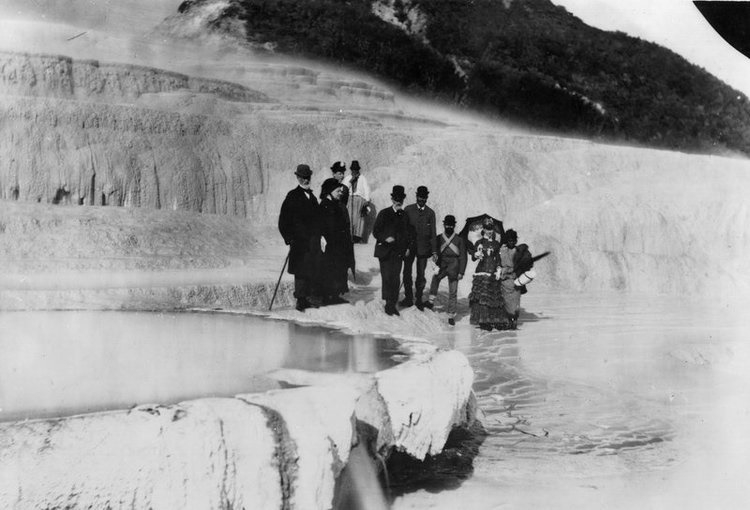Pink and white terraces: beauty discovered, enjoyed and tragically lost
When we hear the words intrepid tourism we tend to think hiking vacations or walking tours, however the 18th century version of intrepid tourism called for a level up, where tourists would travel half the way around the world to visit our famed pink and white terraces, which sat precariously in what would prove to be, a ring of volcanic fire.
Dedicated travellers, both domestic and international, seduced by the sites renowned thermal wonders, committed to a strenuous journey in order to witness the natural magnificence of the Pink and White Terraces and importantly bathe in its silica rich waters. They rode by horse and cart across hills from Rotorua, then two hours by canoe and finally arriving by foot.
Undoubtedly New Zealand’s most famous tourist attraction, the Pink and White Terraces, or Otukapuarangi (fountain of the clouded sky) and Te Tarata (the tattooed rock), attracted people from far and wide.
The white terraces were the larger and arguably more beautiful formations. They covered 3 hectares with a fall of 30 meters.
The smaller pink terraces – due to the high concentration of silica, were the ones that people went to bathe. The waters were silky clear and left the skin feeling soft and refreshed.
The origins
In geographical terms, the terraces were formed as water containing silica flowed from boiling geysers that cascaded down the hillside. The water cooled and crystallised into the terraces and pools, forming what can best be described as giant staircases or waterfalls. This was the natural birth of the pink and white terraces and after their beauty and beneficial properties were discovered, what naturally followed was the birth of intrepid, health-based tourism here in New Zealand.
In its pre-eruption state, the pink and white terraces were the 18th century equivalent of an exclusive and remote holistic spa.
Getting there was physically taxing but on arrival the natural beauty of the terraces would have been so enthralling and magnificent. What the travellers must have witnessed would truly astound and subsequently worth the title of the eighth wonder of the world.
The fateful night
When Mount Tarawera erupted on June 10th 1886, Lake Rotomahana also erupted and this combined effect destroyed the stunning terraces. Understandably photographs and paintings are all that remain of these once beautiful natural wonders.
On that night the terraces collided with what was New Zealand’s greatest natural disaster and just after midnight on June 10th, the people in Te Wairoa were woken by a sequence of smaller earthquakes followed by a much larger one and finally massive explosions. For more than four terrifying hours, rocks, ash and mud bombarded the peaceful village.
As was the effect in other eruption affected areas like Pompeii in Italy, the violent and unexpected eruption buried Te Wairoa and several other smaller villages under hot heavy ash and mud.
With the loss of this beautiful natural wonder came greater consequences other than the immediate affect on tourism. As a sobering reality check, the Tarawera eruption changed the New Zealand landscape significantly, dramatically and permanently.
Greater than that, around 150 people lost their lives and the exact number of casualties has never been determined.
A hope of re-discovery
In February 2011 scientists announced that they had found what they believed to be part of the Pink Terraces, 60m under water in Lake Rotomahana.
When something magnificent is lost in a tragic and unforgiving way, we as a collective country, in some aspect are not given time to mourn or comprehend what we now no longer have and this is only compounded by time.
Future generations hearing of the magnificence will never see this natural wonder, they are captivated by the loss – and equally by the possible discovery.
It fuels our hunger for treasures unearthed or beauty restored and rediscovered.









Connect with Us
Facebook YouTube Instagram Tripadvisor Blog Email